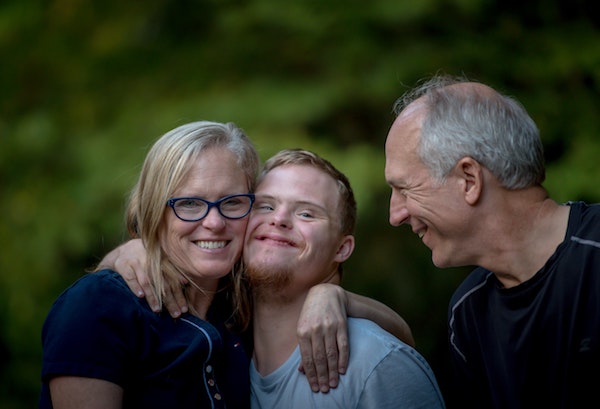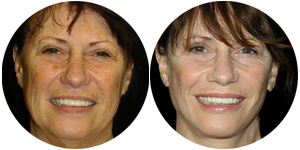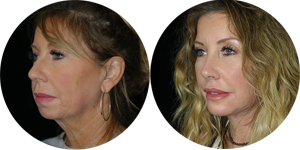Other Craniofacial Diagnoses
Conveniently located to serve the areas of San Diego, CA

The surgeons at FACES+ treat a variety of other craniofacial disorders, including: Hemifacial Microsomia, Treacher Collins and Nager Syndromes, Frontonasal Dysplasia and Hypertelorbitism, Encephaloceles, Craniofacial Clefts, Small or Absent Eyes, Down Syndrome, Benign Subdural Hygroma.
Contents
Hemifacial Microsomia
Hemifacial Microsomia is an underdevelopment of the tissues on one side of the face that occurs in approximately 1 out of 5000 births. Also known as Goldenhar syndrome when eye involvement is present, it affects both sides of the face in approximately 15%. This condition results in an asymmetry of the face with malformation of the ear and an underdeveloped jaw on the affected side. The functional challenges of this condition include an abnormal bite, hearing loss and related psychosocial issues. Characteristics of hemifacial microsomia include:
- Short mandible canted to affected side
- Malocclusion with chin shifted to affected side
- Microtia or small ear
- Diminished cheek soft tissues
- Macrosomia or lateral oral cleft
Treacher Collins Syndrome
Treacher Collins Syndrome results from a bilateral combination of clefts thru the malar and lateral orbital bones that occurs in approximately 1 in 25,000 births. Known as Tessier clefts 6, 7 and 8, these result in a flattened cheek prominence, and downward slanting deficient lower eyelids. The mandible and ears are also underdeveloped. The primary functional problems associated with Treacher Collins syndrome are related to airway, occlusion, hearing and abnormalities of the eyelids. Nager syndrome has the features of Treacher Collins syndrome but it is also associated with defects of the limbs. Characteristics of Treacher Collins and Nager syndromes include:
- Hypoplasia of the cheek bones
- Retrusive lower jaw and chin
- Downward slanting of the eyes
- Lower eyelid and eyelash defects
- Malformation of the ears
- Small or absent thumb (Nager syndrome)
These children require evaluation by a craniofacial team with experienced geneticists, surgeons, dentists, speech and hearing specialists, and psychosocial therapists. When breathing difficulties are present, airway management is the highest priority. Subsequent treatments include correction of orbital and jaw problems, reconstruction of eyelids and ears, speech and hearing correction, and orthodontics.
The craniofacial team at Children’s Hospital of San Diego consists of experienced specialists dedicated to the optimal treatment of children with Treacher Collins and Nager syndromes.
Evaluation by a skilled geneticist is required due to the frequency of associated abnormalities of the vertebrae, heart, and urinary system. Treatment planning requires a craniofacial team to sequence the ear reconstruction, jaw reconstruction, and soft tissue reconstruction. The pediatric craniofacial plastic surgeons at FACES+ have a large experience with these reconstructive procedures. Frontonasal Dysplasia and Hypertelorbitism are conditions characterized by an increased distance between the orbits. In frontonasal dysplasia there is an incomplete migration of the orbits into proper apposition, resulting in widely separated eyes, or hypertelorbitism. Incomplete medial migration of the facial structures can also result in midline clefts of the nose, lip, palate and forehead. Other causes of hypertelorbitism include amniotic band syndrome and ethmoid encephaloceles. Characteristics of frontonasal dysplasia and hypertelorbitism include:
- Widely separated eyes
- Broad nasal root
- Notched nasal tip or divided nostrils
- Deficit in midline frontal bone
Treatment is directed at moving the bony orbits and eyes back together again, and reconstructing the nasal and forehead clefts. These complex procedures require a surgical team composed of a pediatric craniofacial plastic surgeon, oculoplastic surgeon and neurosurgeon. The FACES+ surgeons, directors of the San Diego Children’s Hospital Craniofacial Surgery Team, have an extensive experience with the correction of frontonasal dysplasia and hypertelorbitism using the latest techniques and technologies.
Encephaloceles
Encephaloceles are conditions where the underlying brain, with its covering, protrudes through a defect in the skull. This usually occurs in the midline of the skull, in the area between the forehead and nose or in the back of the skull. Usually encephaloceles are dramatic and diagnosed immediately after birth. Occasionally a small encephalocele in the nasal and forehead region will go undetected for a while. Diagnosis can be confirmed with a CT scan. Characteristics of encephaloceles include:
- Midline bone defect in front or back of head
- Soft and compressible swelling
- Pulsation of herniated tissue
- Increase in size while straining
Treatment consists of placing the herniated brain back inside the cranium, repairing the meninges or brain covering, and reconstructing the bony defect in the skull. For optimal outcome this surgery is carried out by an experienced team with a pediatric craniofacial plastic surgeon and a pediatric neurosurgeon.
Craniofacial Clefts
Craniofacial Clefts are rare conditions that result from a failure of fusion of bone and soft tissues of the face. They may be unilateral or bilateral, and located along or away from embryologic fusion planes. Causes may include genetic factors and environmental factors such as maternal drug and chemical use, dietary deficiency and metabolic disorders. Determination of these potential causes requires an experienced pediatric dysmorphologist. Problems that must be managed in children with craniofacial clefts include:
- Breathing and airway problems
- Feeding and dental problems
- Visual and eyelid problems
- Psychosocial problems
- Neurological problems
Treatment of craniofacial clefts requires the efforts of multiple specialists such as neurologists, eye doctors, ears-nose-throat doctors, dentists, and psychologists. The experience of the craniofacial surgery team can be a key to better outcomes and fewer complications. The FACES+ pediatric craniofacial surgeons working at Children’s Hospital of San Diego are experienced with the repair of craniofacial clefts of all levels of severity.
Small or Absent Eyes
Small or Absent Eyes is a rare condition, usually unilateral, that results from incomplete development of the eye or from incomplete development of the optic connection from the brain. When the eye is small, the condition is known as microphthalmos. If no eye is present, it is termed anophthalmos. When the eye is small or absent, the bony socket also fails to grow. Problems that must be managed in children with small or absent eyes include:
- Enlargement of the bony orbit
- Widening of the eyelids
- Deepening of the recesses behind the eyelids
- Fitting and retention of an artificial eye
The treatment of children with small or absent eyes should be started in the first months of life to minimize secondary deformities due to collapse of the face around the missing or small eye. Placement of a tissue expander behind the missing or small eye can be used, in place of the normal eye growth, to enlarge the eye socket and prepare it for an artificial eye. When treatment is started later, craniofacial surgical techniques are utilized to widen the bony walls and conformers are used to increase the eyelid space to hold an artificial eye. The FACES+ pediatric craniofacial plastic surgeons work with an experienced oculoplastic surgeon and ocularist to achieve the best results in children with small or absent eyes.
Down Syndrome

Down Syndrome, or trisomy 21 syndrome, varies in prevalence in different populations from 1 in 600 to 1 in 2000 births. A variety of physical manifestations are present, including differences in facial features. Facial features characteristic of Down syndrome include:
- Epicanthal folds and slanting eyes
- Flatness of the nose
- Underdevelopment of the upper jaw
- Enlargement of the tongue (macroglossia)
- Recessed chin
Craniofacial surgeons are asked to assist with a variety of problems in children and young adults with Down syndrome including: breathing and sleep apnea, tongue size, bite and appearance. After a sleep study and other appropriate tests, widening and moving forward the upper jaw can often address airway problems. The bite and appearance are also improved with this procedure. If the tongue is unable to be controlled or maintained in the mouth, a wedge can be removed to shorten and narrow the tongue. Surgical procedures can bring excellent outcomes to properly selected patients, but they must be carefully considered before any decision is made.
Benign Subdural Hygromas
Benign Subdural Hygromas of infancy are a relatively common occurrence associated with prominence of the forehead and rapid head growth in early infancy. A CT scan of the skull reveals extra fluid outside the brain, but underneath its covering membrane or dura, leading to changes in skull shape. Most of these children only need routine follow up observation, as the head deformity is self-correcting. They occasionally have developmental delay initially, as the large head slows acquisition of motor skills. They invariably catch up between one and one-half to three years of age.



